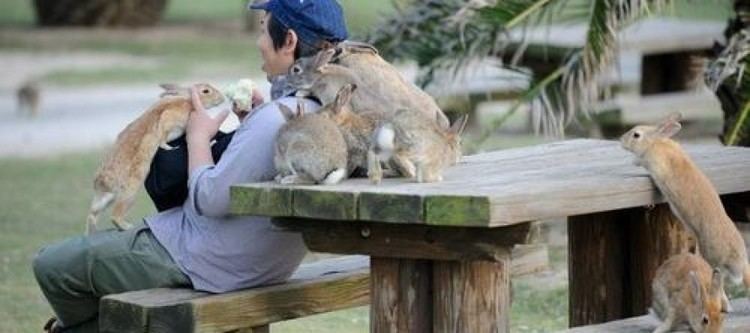Area 70 ha | ||
 | ||
Points of interest Ōkunoshima poison gas museum, Power Plant Ruins, Okunoshima Island Poison G, Okunoshima Island, 北部砲台跡 Similar Ōkunoshima poison gas museum, Tadanoumi Station, Tashirojima, Itsukushima, Aoshima - Ehime | ||
Island of bunnies and poison kunoshima documentary
Ōkunoshima (大久野島) is a small island located in the Inland Sea of Japan in the city of Takehara, Hiroshima Prefecture. It is accessible by ferry from Tadanoumi and Ōmishima. There are campsites, walking trails and places of historical interest on the island. It is often called Usagi Shima (うさぎ島?, "Rabbit Island") because of the numerous feral rabbits that roam the island; they are rather tame and will approach humans.
Contents
- Island of bunnies and poison kunoshima documentary
- Map of C58Ckunoshima Tadanoumicho Takehara Hiroshima Prefecture 729 2311 Japan
- The paradise of rabbits kunoshima
- History
- Present
- Poison Gas Museum
- Other buildings and structures
- Travel
- References
Map of %C5%8Ckunoshima, Tadanoumicho, Takehara, Hiroshima Prefecture 729-2311, Japan
Ōkunoshima played a key role during World War II as a poison gas factory for much of the chemical warfare that was carried out in China.
The paradise of rabbits kunoshima
History
The island was a cultivated area until the Russo-Japanese War when ten forts were built to protect it. Three fishing families lived on the island.
In 1925, the Imperial Japanese Army Institute of Science and Technology initiated a secret program to develop chemical weapons, based on extensive research that showed that chemical weapons were being produced throughout the United States and Europe. Japan was a signatory on the 1925 Geneva Protocol which banned the use of chemical warfare. Although the development and storage of chemical weapons were not banned, Japan went to great lengths to ensure the secrecy of construction of the chemical munitions plant begun in 1929, even going so far as to remove records of the island from some maps. The plant was built over the period of 1927 to 1929, and was home to a chemical weapon facility that produced over six kilotons of mustard gas and tear gas.
The island was chosen for its isolation, conducive to security, and because it was far enough from Tokyo and other areas in case of disaster. Under the jurisdiction of the Japanese military, the local fish preservation processor was converted into a toxic gas reactor. Residents and potential employees were not told what the plant was manufacturing and everything was kept secret; working conditions were harsh and many suffered from toxic-exposure related illnesses.
With the end of the war, documents concerning the plant were burned and Allied Occupation Forces disposed of the gas either by dumping, burning, or burying it, and people were told to be silent about the project. Several decades later, victims from the plant were given government aid for treatment. In 1988 the Ōkunoshima Poison Gas Museum was opened.
Present
Many rabbits live on the island. When the island was developed as a park after World War II, these rabbits were intentionally set loose. Many rabbits were used in the chemical munitions plant to test the effectiveness of the chemical weapons during World War II. Those rabbits were killed when the factory was demolished. According to Murakami, the former director of the poison gas museum, the current rabbits have nothing to do with those that were involved with chemical weapon tests.
Hunting these creatures is forbidden, and dogs and cats may not be taken onto the island. The ruins of the old forts and the gas factory can be found all over the island; entry is prohibited as it is too dangerous. Since it is part of the Inland Sea National Park system of Japan, there is a resource center and across the way is the museum.
In 2015, the BBC presented a short television series called Pets - Wild at Heart, which featured the behaviours of pets, including the rabbits on the island. The series depicted various tourists coming to feed the rabbits.
Poison Gas Museum
Opened in 1988, the museum "was established in order to alert as many people as possible to the dreadful truths about poison gas."
Only two rooms large, the small building provides a basic overview of the construction of the plant, working conditions and the effects of poison gas on humans. Families of workers who suffered the aftereffects of the harsh working conditions donated numerous artifacts to help tell the story of the workers' plight when handling the gas with poor safety equipment that often leaked.
The second room shows how poison gas affects the human body through the lungs, eyes, skin, and heart. Images of victims from Iraq and Iran add to the message of the museum.
As expressed by the curator Murakami Hatsuichi to The New York Times, “My hope is that people will see the museum in Hiroshima City and also this one, so they will learn that we [Japanese] were both victims and aggressors in the war. I hope people will realize both facets and recognize the importance of peace."
In the museum one can pick up a guide to the numerous remains of the forts from the Second Sino-Japanese War and the poison gas factory. Most of the buildings are run-down and condemned, but recognizable.
The museum is aimed mainly at the Japanese people, but English translations are provided on the overall summary for each section.
Other buildings and structures
The island is connected by Chūshi Powerline Crossing, the tallest powerline in Japan.
Travel
The best way of accessing the island from the mainland is to take the Sanyō Shinkansen train to Mihara Station (only the Kodama stops there); at Mihara, catch the Kure Line local train to Tadanoumi, from there walk to the terminal and catch a ferry.
